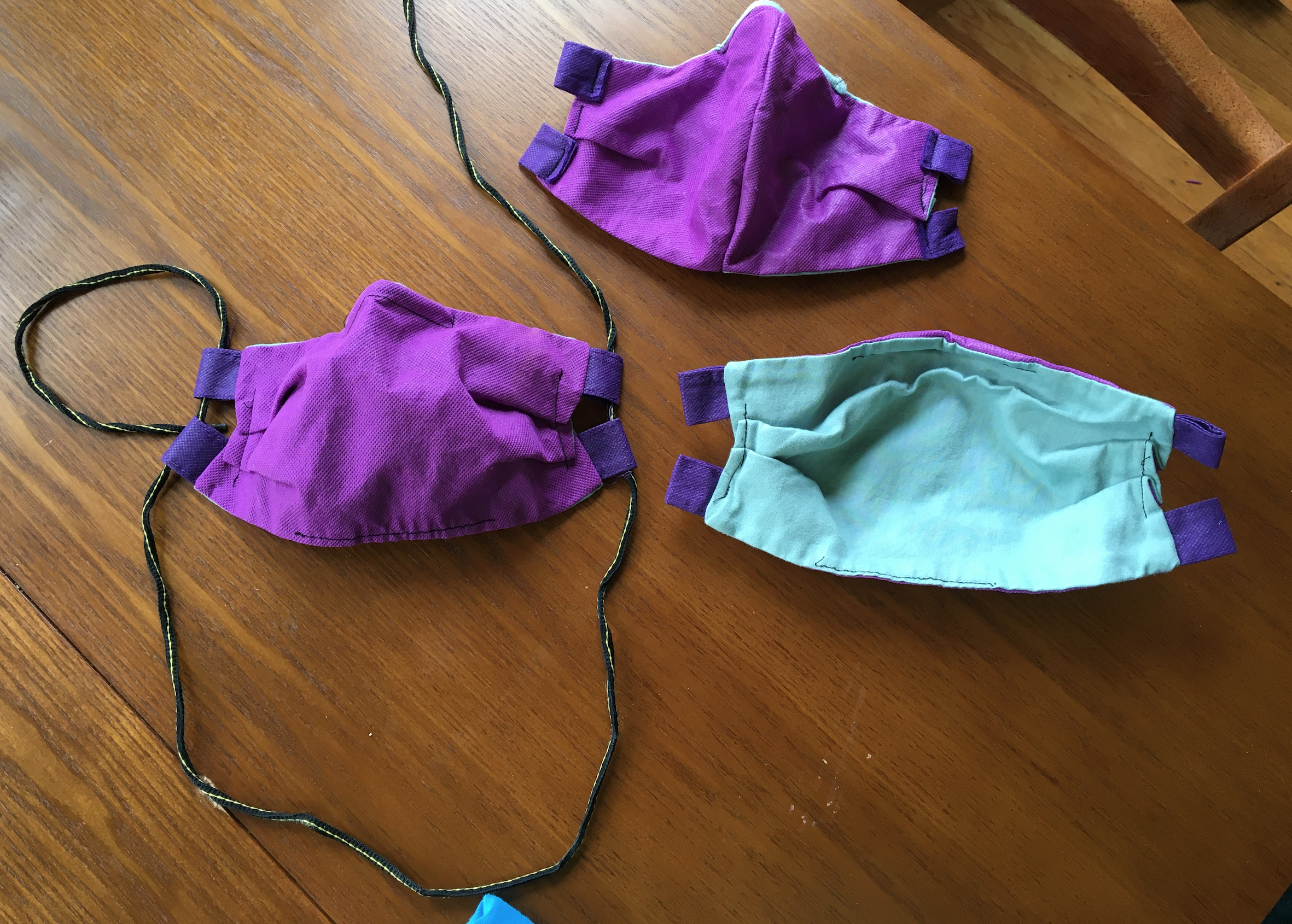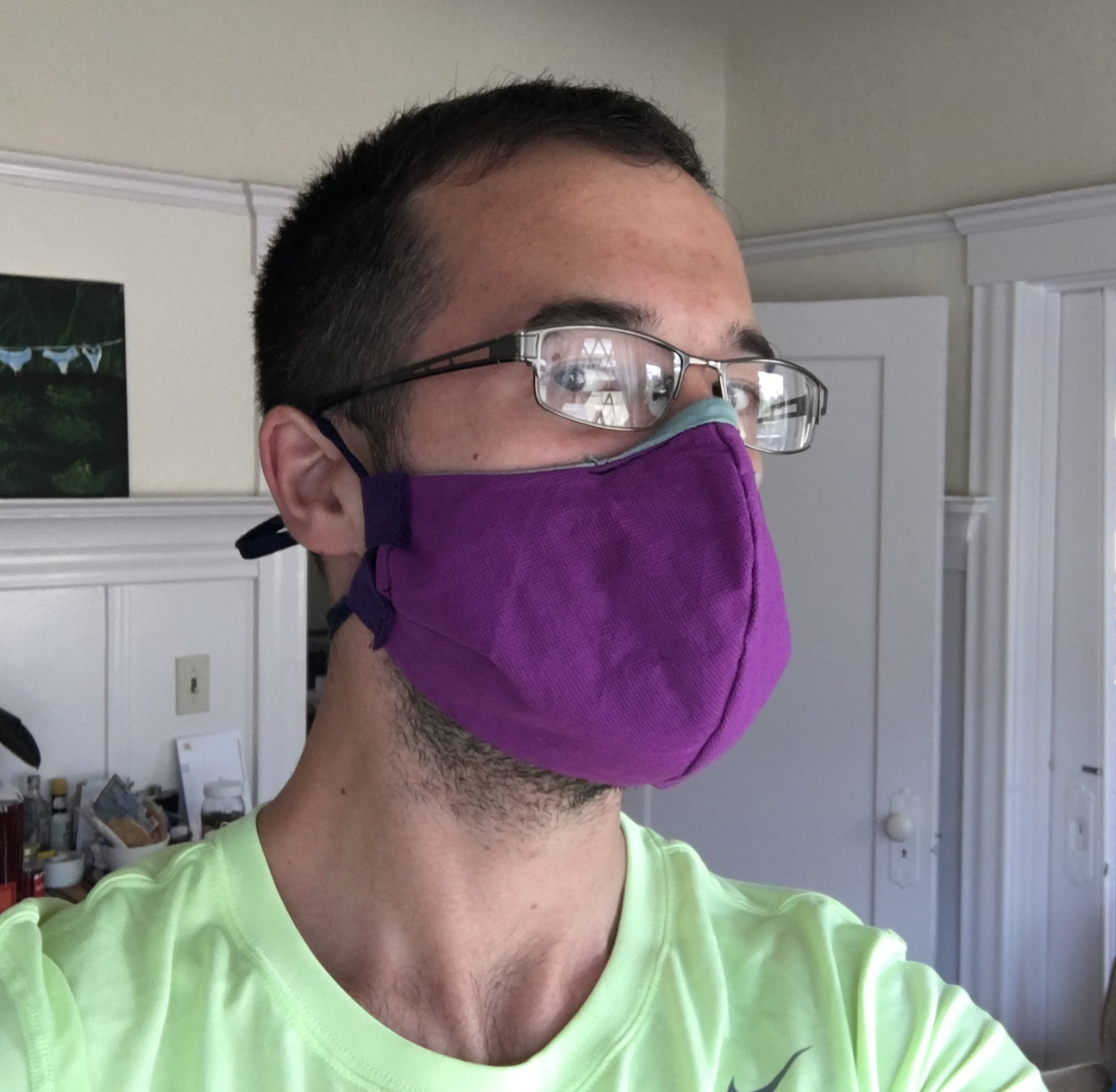Masks for COVID-19
Disclaimer: I am not a doctor or public health official, and you should follow the recommendations of your local health officials and the CDC, especially if they conflict with any information presented here.
What type of mask to wear
The CDC has recommended that all Americans wear masks in public. However, the guidelines can be confusing so this post attempts to clarify the what, when, and how of masks for COVID-19.
The first important point is that any mask is better than no mask! The point of masks for the general public is to slow the spread of disease by filtering droplets, not by providing complete protection from viruses.
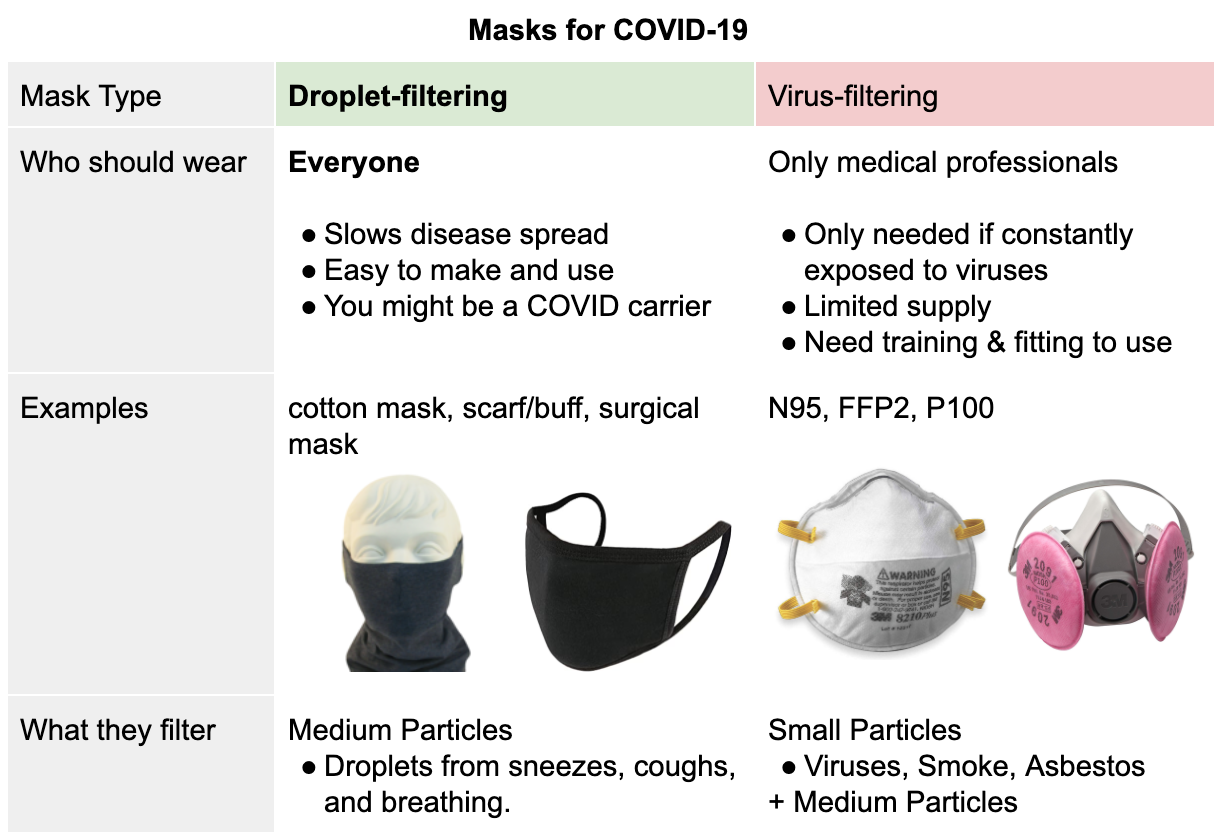
Side note: many commercial p100 and n95 respirators have “outflow” valves that let air bypass the filter when exhaling. This severely decreases their effectiveness at reducing virus spread and they should be avoided or modified if you want to use one your already own for COVID-19 protection.
When to wear a mask
Wear a mask anytime you’re in public and around other people, especially indoors. That means grocery stores, gas stations, doctors’ offices, etc. This is important to mitigate the spread of droplets you emit when you sneeze, cough, or simply breathe. These droplets contain viruses if you’re infected and can travel several feet and hang in the air for minutes to hours! For example, see videos about droplet dispersal while inside in a room or outside on a run or biking. You may be a carrier for COVID-19 and not know it, so it’s important to protect others.
NOTE: Masks do not provide perfect protection, and you should only use them in addition to other preventative measures, not instead of them. You should still follow social distancing, wash hands frequently, and stay home as much as possible.
How to make a DIY droplet-filtering mask (easy)
It is easy to make a DIY (do-it-yourself) droplet-filtering mask to prevent droplets from coughing, sneezing, or breathing from dispersing very far from the wearer. Almost any design will work for this purpose and help to slow the spread of COVID-19. For these masks, it is good enough to use one or two layers of cloth with a tight weave like 100% cotton cloth, flannel, or bedsheets.
Follow any of these directions to make an easy DIY mask:
- CDC guidelines - how to sew a mask or make one out of a bandana or t-shirt.
- Washington Post - how to sew or cut a mask.
- Analysis of materials for DIY masks - suggests 100% cotton T-shirts or pillowcases
- Instructables guide - how to sew a slightly nicer mask.
To emphasize, any mask is better than none and will help to filter droplets. This is all that most people in the general public need. However, if you want to make an “advanced” DIY mask, keep reading.
DIY virus-filtering masks (difficult)
Some DIY masks can also provide some virus-filtration in addition to droplet-filtration, similar to commercial “virus-filtering” masks like N95 used by medical professionals. However, evidence of how effective DIY masks are at filtering viruses is mixed and highly variable depending on the material, construction, and use of the mask.
If you want to try to create a DIY virus-filtering mask, you must achieve three things:
- A mask design that fits tightly to your face
- Material that is breathable
- Material that filters viruses
First, to achieve a proper fit (#1) requires a metal nosepiece and contoured mask design such as this design from instructables. However, masks are not “one size fits all” and you may have to experiment to find what works for you. It is very difficult to achieve a good fit – medical professionals must go through a “fit test” for their masks and friends have said it often takes multiple attempts to pass.
Then, you must use a material that is both breathable (#2) and filters viruses (#3). There are many materials that can filter viruses, but most are very difficult to breathe through. Breathability is MORE important than virus filtration, as if the material is not breathable the virus-laden air will simply leak around the edges of the mask as you breathe.
From published literature, blog posts, and home experimentation, I’ve assembled the table below listing materials that may work to filter viruses. Materials in BOLD are recommended as good options. Note that these are rough estimates and not hard data.
Mask materials for COVID-19
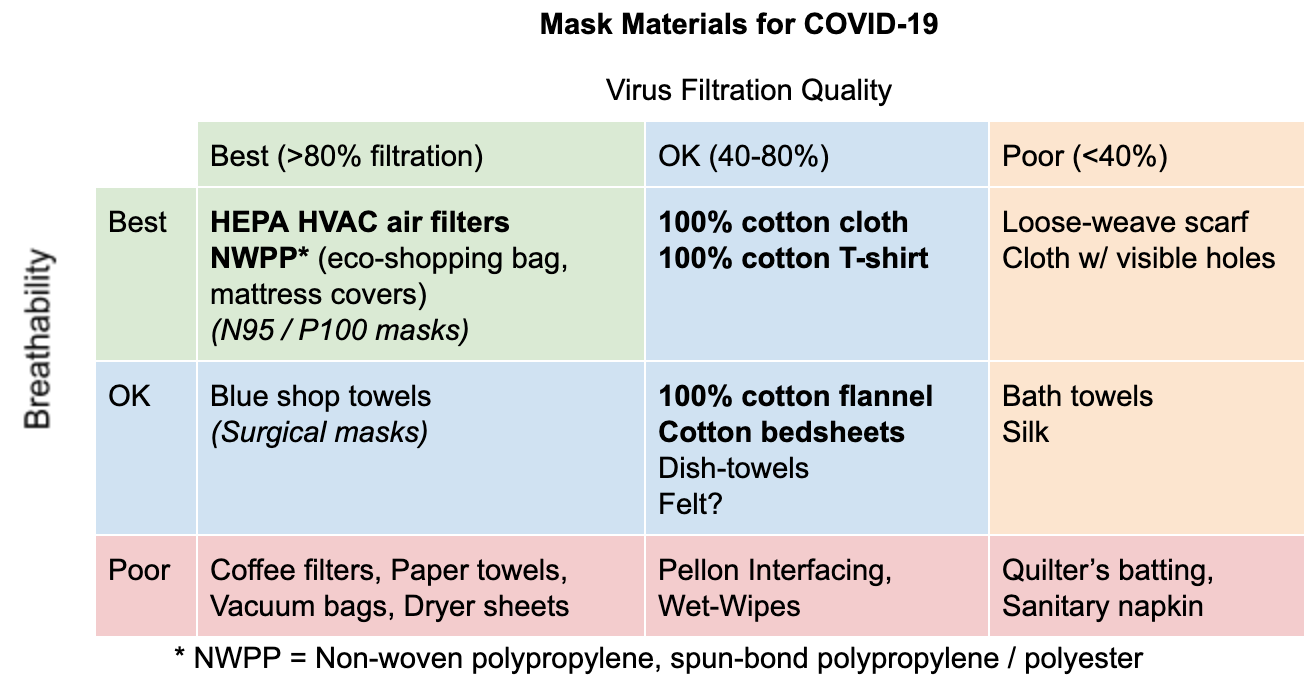
The takeaway is that a non-woven polypropylene (NWPP) material may work well to filter viruses. NWPP is used for many reusable shopping bags and mattress covers, and spun-bond polypropylene or polyester fabrics are similar and may also work.
In addition, HEPA HVAC filters are both breathable and filter viruses – However, HVAC filters may shed small fibers that could be hazardous to breathe, so should only be used as a filter layer, and the mask must include a layer of tight-weave cotton between the HVAC filter and your face.
Example filter material
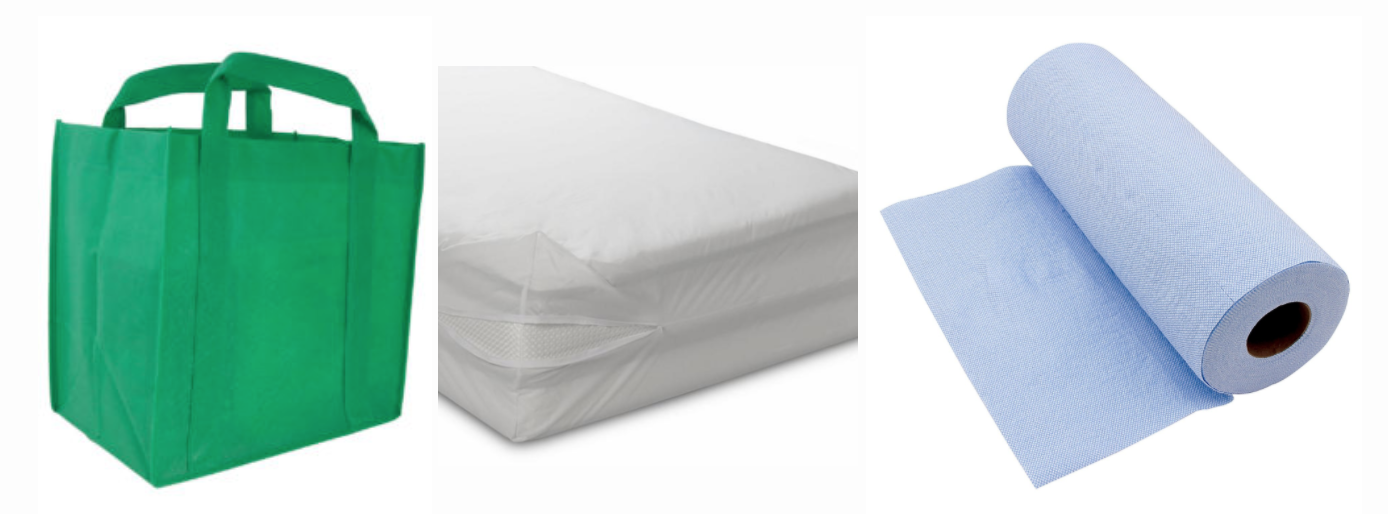
You could also use blue shop towels as they are non-woven cloth and have fairly good breathability. However, they are not machine-washable, so they are only suitable as a disposable filter insert. Coffee filters, vacuum bags, and paper towels are also non-woven have been shown by several studies to filter viruses, but my experiments show they have poor breathability and are thus not that effective for making virus-filtering masks.
I’ve found that a two-layer mask design with an outer layer of NWPP and an inner liner of 100% cotton bedsheet for comfort against the face works well, but that three-layer designs became difficult to breath through.
References for Filtration and Breathability:
- The Craft Patch Blog - experiments on breathability of materials & links to research
- Maker Blog - experiments on breathability of materials
- NYTimes article - cites many research groups examining mask materials
- Academic study on cloth masks (2010) - tests common fabrics for filtration efficiency
- Academic study on cloth masks (2013) - tests common fabric and mask designs for filtration and breathability
How do air filters work?
What makes a good filter material? Why is non-woven cloth recommended?
Filters must allow air to move through easily while trapping viruses and particles. You could imagine trying to build a mesh filter that works like a pasta strainer – a solid sheet with small holes. However, if you tried to make a mesh filter small enough to filter viruses, it would be difficult to manufacture, thin and easy to tear, and be very difficult to breathe through.
Instead, air filters are constructed like a messy “tangle” of tiny fibers. As air moves past fibers, droplets and particles “stick” to fibers and get trapped. Thus, more “tangled” fibers means particles have more chances to get stuck and the filter is more effective (there are many more details, but this is the gist). Below are microscope pictures of the fibers of a new, clean air filter (a) and a dirty filter after accumulating lots of droplets (b).
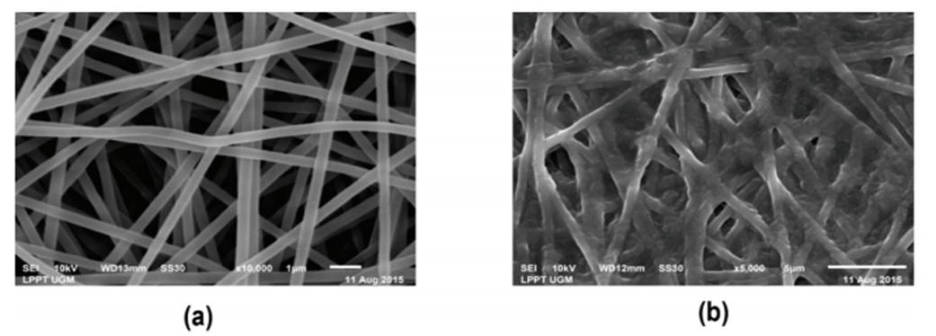
The problem is that many common fabrics are loosely “woven” and have big holes, letting air go through without passing by many fibers. Thus, many particles slip through without sticking to the fibers.
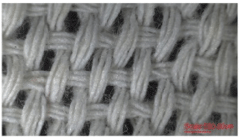
Below is a real picture of cotton cloth taken using an electron microscope. The green circles represent sneeze or cough droplets and are drawn to-scale (10-100 microns).
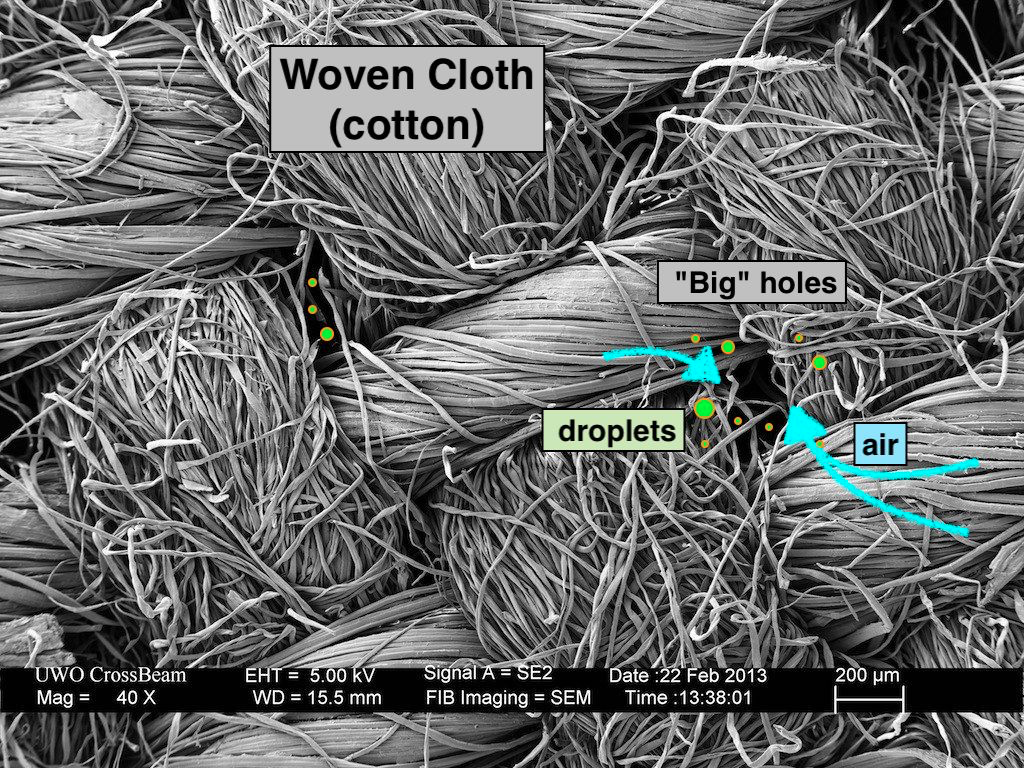
The holes are quite large and allow air and droplets to pass through. Smaller holes let fewer droplets through, so a tighter weave is a better filter. However, tighter weaves also reduce breathability.
Commercial air filters and masks instead use non-woven material. The air must travel a twisty path past many more individual fibers, filtering many more particles while still letting air through.
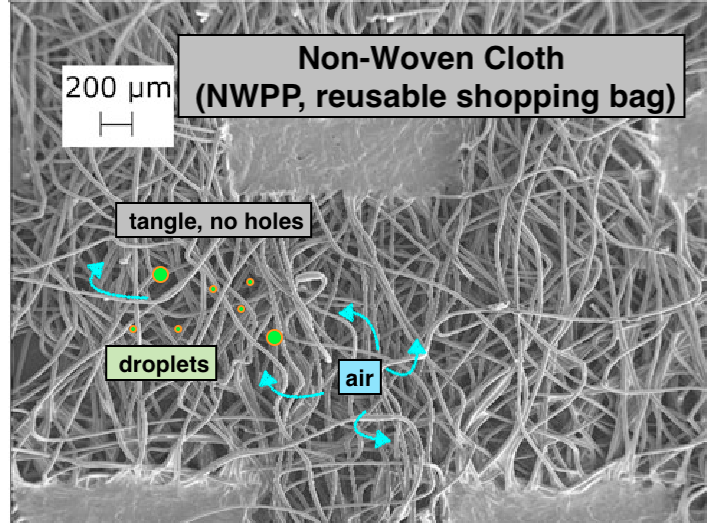
If you want to improve virus-filtration for your homemade mask, use a non-woven material like NWPP from reusable shopping bags or mattress covers. I’ve found a two-layer mask of 100% cotton inside for comfort and NWPP outside works well. If you can’t find NWPP, use 100% cotton cloth, T-shirt, or flannel with a high thread-count and tight weave.
Takeaways
- Everyone should wear a face-covering anytime they are in public to block their coughs and sneezes.
- Any DIY mask design of any material is better than no mask.
- If you want to create a DIY virus-filtering mask, use a design seals to your face well and try to find a non-woven cloth to use as a filter material.
References:
- Argument for NWPP for masks - suggests NWPP (reusable shopping bags)
- Instructables - suggests 100% cotton, HEPA filters, or non-woven material (NWPP)
- Masks can help
- More than you wanted to know about face masks
Postscript: My Masks
For inspiration, here are some masks I’ve sewn using an old bedsheet, reusable shopping bag, paperclips wrapped in electrical tape, and shoelaces. I generally followed the guidelines in this instructables guide but with some modifications to make the mask fit my face and advice from my mom who has her own mask design. My mask is quite comfortable for me and seals fairly well – it does not fog my glasses at all. I’m even able to comfortably wear it on runs and bike rides.
